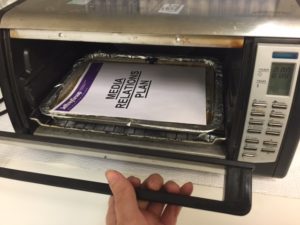The Recipe to Successful Media Relations
 With the holidays fast approaching, you’re probably thinking about cooking festive meals that will not only satisfy, but also impress, your friends and loved ones. You might have some experience preparing a meal, but to avoid mistakes you decide to follow a proven recipe. And the same applies to media relations: sometimes you need to stick to the basics and follow the recipe to get the results you want.
With the holidays fast approaching, you’re probably thinking about cooking festive meals that will not only satisfy, but also impress, your friends and loved ones. You might have some experience preparing a meal, but to avoid mistakes you decide to follow a proven recipe. And the same applies to media relations: sometimes you need to stick to the basics and follow the recipe to get the results you want.
As a former journalist for many years, I know how the media think. Before distributing a press release or a pitch I always ask myself, “If I were sitting at my old newsdesk, would I want to write about this? What would my editor say if I pitched him/her this story? Is this something that would be interesting to our readers?”
I learned this recipe for successful media relations when studying my Master in Strategic and Innovative Communications at the University of Malaga and working at JeffreyGroup. In the spirit of the holidays, I’m sharing it with you.
Ingredients
· 1 lb. news (or replace with interesting story angles if your client doesn’t provide)
· 2 cups of communications outputs
· 1 cup of honesty
· 1 liter of rapport and enthusiasm
· 2 tablespoons of patience
· 1 informed and media-trained spokesperson
Directions:
Before preparing, media-train one senior-level spokesperson. Marinate him/her overnight with key messages, interview dos and don’ts, communications theory and a minimum of three interview simulations.
In a large bowl, combine one pound of news (or interesting story angles) and two cups of communication outputs, such as fact sheets, backgrounders, spokesperson bios and press releases. Remember to personalize the outputs to taste. News is tasty enough on its own, though, so avoid adding unnecessary condiments.
Add 1 cup of honesty. This means not hiding important information about your company, service or product from consumers. In the end, media will appreciate you for not spinning the truth, and rely on you instead as a trusted source of information.
Combine with a local ingredient. Adapt global communications to make them interesting to local markets.
Slowly pour in one liter of rapport and enthusiasm. Remember the importance of delivery. How can you get a journalist excited about your client’s news when you are not?
Add a dash of good social listening. What are the media saying about your client? What conversations are taking place about your client in social media? Monitor these digital conversations closely so that you know what topics interest the media.
Toss clear and direct messages with attractive visuals, such as high-resolution images. Ensure your messaging is not excessive; otherwise, it loses its flavor. Add to the mixture.
Set oven to 350 degrees Fahrenheit, carefully mix all ingredients, add the spokesperson, and place in baking dish for 2 hours. Remember to be patient and diligent about following up. Give the journalist enough time to smell what you are cooking, but not too long that he/she will lose interest.
When done, serve while hot to the right journalist at each publication. Journalists find few things more annoying than receiving a pitch or release that is irrelevant to them.
Follow this recipe, and you will never burn your media relationships. Instead, media will look to you as a trusted source of information and proactively reach out to you to know what is cooking with your clients.

